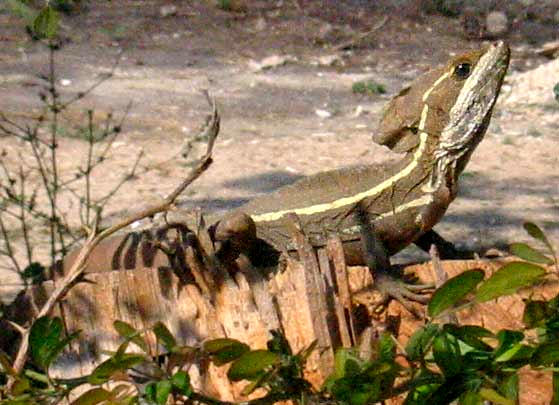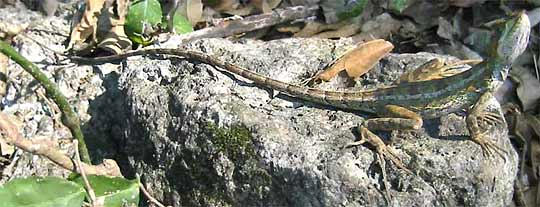Excerpts from Jim Conrad's
Naturalist Newsletter
from the April 7, 2008 Newsletter written in the community of 28 de Junio, in the Central Valley 8 kms west of Pujiltic, elev. ~700m (2300ft), ~N16.331°, ~W92.472°; southeastern Chiapas state, MÉXICO One of our most common and certainly the most striking of our lizards is the Striped Basilisk, BASILISCUS VITTATUS. Each morning as I pass to and from the reserve a certain 15-inch male suns himself atop the stump of a Guamuch tree next to a peacefully flowing, shaded canal. That's him above. Basilisks have their own lizard family. There's the Iguana Family, the Anole Family, the Racerunner Family, the Skink Family, etc. They're all "lizards," but important differences separate the families. Basilisks are immediately recognizable because the males, at least, bear amazing crests, casques or helmets atop their heads, plus all basilisks possess extremely long legs and tails. Locally our Striped Basilisks are called
"Teleches" but in Tuxtla just to the west they're called "Nacahuas." By whatever name this species is one of the best-known of all lizards from here to northern South America. That's because it's so often seen running across roads and other open areas. And by running I mean that it rears up on its hind legs, holds its front legs up like arms, and with its chin pointed at the sky it looks more like a cartoon caricature of a running lizard than what we'd expect a real running lizard to look like. Striped Basilisks nearly always remains close to water. When they need to escape to a far bank they do so by simply by running across the water's surface! This is possible because of well-developed fringes on the sides of their hind toes. Normally the fringes stay folded but when the lizards dash across water they open up, providing the animals' feet with more surface area to press against the water and hold them up. I've heard irreverent gringos call Striped Basilisks "Jesus Lizards" because of their water- walking disposition. Often instead of running atop the water they dive below it. These are truly water- adapted lizards. Striped Basilisks pay for their popularity, however. Campbell's Amphibians & Reptiles of Northern Guatemala, the Yucatán & Belize reports that they fall prey to a large variety of animals, especially snakes, and that only about 2% of hatchlings survive for two years. Striped Basilisks feed mostly on insects but also on fallen fruits.
STRIPED BASILISKS

FROM THE MAY 12, 2008 NEWSLETTER
A FEMALE STRIPED BASILISK
We've already met a male Striped Basilisk with its slender, very long tail, very long legs and flaplike crest atop its head. Saturday I got a good picture of a female, shown below:

I'm glad to have a female's picture because the species is sexually dimorphic -- males look different from females. You can see that the female lacks the male's crest and his conspicuous, yellowish, solid line running from the eye down the sides and tail, plus the female's back is checkered instead of plain. This female in the picture is about a foot long.
You can also see the very long back legs and toes characteristic of basilisks, features hidden in my picture of the male. Those expansive feet enable furiously running basilisks to run across water.